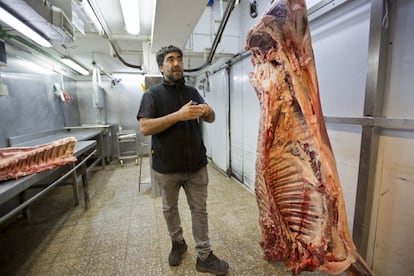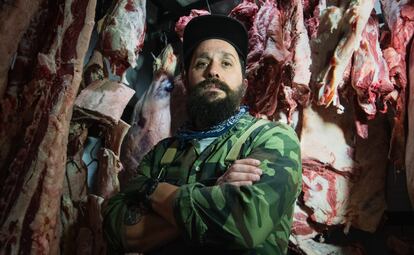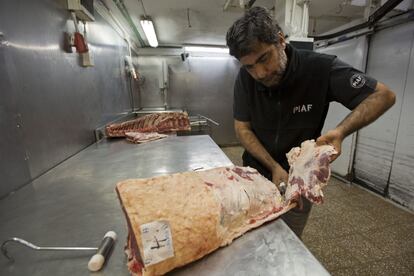Argentinian butchers carve themselves a niche
This carnivorous country, where 46 kilos of beef per person was consumed last year, resists supermarket trends to keep a centuries-old trade alive


“Forgive my enthusiasm,” says Hernán Méndez, 50, owner of the Piaf butcher shop in Buenos Aires. Knife in hand, he points out the rib, the loin, the roast top and the round on the half-carcass that hangs next to the refrigerators. Deep within the carcass lies the “secret,” a cut, he says, that is the jewel in the crown where his business is concerned.
Méndez studied to become a school teacher and he probably would have done very well in that profession: he clearly has pedagogical ability and is passionate about his field of expertise. But when his father inherited the tiny butcher shop where he had worked as a cashier, Méndez dropped everything and switched to meat. He is now one of more than 5,000 butchers in the Argentinian capital, heirs to a tradition that is passed on by word of mouth. There was a time when the trade was threatened by the sale of packaged meat in supermarkets. But it has turned out to be a case of David defeating Goliath.
There are around 50 million head of cattle in Argentina and 90% of the meat is sold on the domestic market. In 2021, Argentinians ate about 46 kilos of beef per person, a quantity comparable only to that consumed by their Uruguayan neighbors. The figure is far lower than the 98 kilos consumed back in 1958, when statistics from the Institute for the Promotion of Beef and Veal (IPCVA) began, but it still outstrips the 6.5 kilos world average by a long chalk. Seventy-five percent of all that enormous amount of protein is sold in neighborhood stores. “Today we are fighting to give value to the trade, and that means knowledge,” says Méndez. “It was something we had and did not see.”
Argentinian beef comes from strains of cattle developed 150 years ago in the United Kingdom, especially the Hereford and Aberdeen Angus breeds. Combine this with the benefits of the temperate climate in La Pampa province, its first-class pastures and plenty of drinking water and you get a culture of meat consumption, with the butcher in the role of shaman behind each roasting ritual.

Nowadays, those who own small stores inherited from their parents and grandparents are being joined by a younger generation seeking to add value to the meat trade by introducing gourmet items. The epicenter of this new approach is the Palermo district, where dozens of classy restaurants thrive alongside designer clothing stores, craft breweries, bicycle shops and bookstores. Ariel Agomaniz opened his shop nine years ago, calling it Amic, which means “friend” in Catalan, in a nod to time he spent in Barcelona. He is 42 and wears a hipster beard, a cap and a tattoo on his right forearm that says, To beef or not to beef. “People have gone back to the butcher shop because they want to know what they’re getting,” he says. “They like to talk to the butcher. If you only offer packaged meat, they feel they are missing something.”
Agomaniz sips a glass of wine next to the bar of La Carnicería, a grill that brings together four butchers on Thursday nights in a tribute to the trade, including Méndez and Victoria Vago, a political scientist who dropped everything for a career in meat. Also at the grill is Carlos “Nucho” Príncipe, who has been behind the counter of his shop for 60 years in the 100-year-old El Progreso market, located in Caballito, a typical Argentine middle-class neighborhood.

Nucho inherited the butcher shop that his grandfather founded in 1935. Now 73, he has passed it on to his two sons. “I don’t charge my customers,” he says. “I charge them for the labor, because the meat goes for free.” And he laughs. “The meat arrives at 4am at the market and you have to be there to get it. And you stay there until 9pm. You either love this or you don’t do it. I dedicated myself with a passion, like Messi dedicates himself to the ball or Nadal to the racket. Nothing compares to meat. You get bored of fish and chicken, but meat can surprise you every day. And the butcher has to be part of the process, to talk, to listen to the customer’s problems and become an advisor.”
Running La Carnicería restaurant are chefs Germán Sitz and Pedro Peña. Sitz raises his own cattle in La Pampa and brings the meat directly to the restaurant’s grill. He emulates much of the effort made by the Argentinian butcher to use the whole carcass, in an exercise that requires years of practice wielding the knife. “In the United States, for example, only a few cuts are used, such as the ribs, while the rest is minced for hamburgers,” he explains. “Here, everything is used, with no grinding.”
Ernesto Jáuregui is an agricultural engineer and manages the Sitz family farm. The quality of Argentinian beef, he says, lies in the free-range aspect of farming, when the animals are fattened on pasture. The free-range treatment “is only applied during the final 30 to 90 days to homogenize the herd,” he says. “The meat is tender, because pasture feeding stops the acceleration of growth, which lasts about 22 months, compared to 15 months in other countries.”

The most common cuts on an Argentinean table are the bigger ones, which makes sense. Méndez explains that “a food expert knows that 30 milanesa cutlets can be got from one round and he doesn’t need an Excel sheet to work it out.” But the new generation intend “to side-step this restriction and present cuts that are not as commercially convenient - from an animal weighing 500 kilos, I take a cut called an oyster steak that weighs 150 grams. If you put an oyster steak on the menu, you have to kill all the cows in town to get enough of them.”
The economic crisis and cultural changes have seen meat consumption drop in Argentina. But traditions are stronger than financial concerns, as Nucho, the Caballito neighborhood oracle, points out: “Meat will continue to exist,” he says. “The normal thing is to eat 200 grams per person, and here we calculate half a kilo and at the end you buy a kilo. Four people put a whole rack of ribs on the grill. That is the Argentinian magic.”
Tu suscripción se está usando en otro dispositivo
¿Quieres añadir otro usuario a tu suscripción?
Si continúas leyendo en este dispositivo, no se podrá leer en el otro.
FlechaTu suscripción se está usando en otro dispositivo y solo puedes acceder a EL PAÍS desde un dispositivo a la vez.
Si quieres compartir tu cuenta, cambia tu suscripción a la modalidad Premium, así podrás añadir otro usuario. Cada uno accederá con su propia cuenta de email, lo que os permitirá personalizar vuestra experiencia en EL PAÍS.
¿Tienes una suscripción de empresa? Accede aquí para contratar más cuentas.
En el caso de no saber quién está usando tu cuenta, te recomendamos cambiar tu contraseña aquí.
Si decides continuar compartiendo tu cuenta, este mensaje se mostrará en tu dispositivo y en el de la otra persona que está usando tu cuenta de forma indefinida, afectando a tu experiencia de lectura. Puedes consultar aquí los términos y condiciones de la suscripción digital.
More information
Archived In
Últimas noticias
Maduro pleads not guilty before the federal court in New York: ‘I am still the president of Venezuela’
A new test can detect Alzheimer’s from a finger prick
UN team enters Sudanese city of El Fasher after paramilitary massacre: ‘It’s like a ghost town’
A recipe for resistance: Indigenous peoples politicize their struggles from the kitchen
Most viewed
- Gilles Lipovetsky: ‘If you want to live better and fall in love, take Prozac, don’t look to philosophy’
- Alain Aspect, Nobel laureate in physics: ‘Einstein was so smart that he would have had to recognize quantum entanglement’
- Alvin Hellerstein, a 92-year-old judge appointed by Bill Clinton, to preside over Maduro’s trial in New York
- Maduro’s downfall puts China’s relationship with Venezuela to the test
- Why oil has been at the center of Venezuela-US conflicts for decades










































